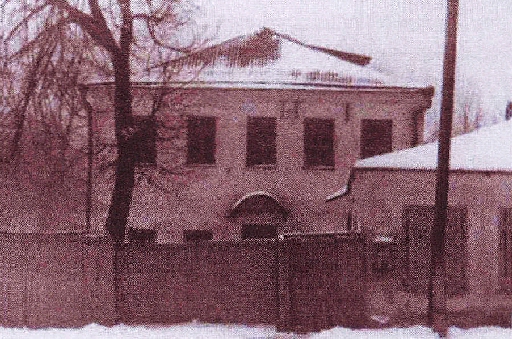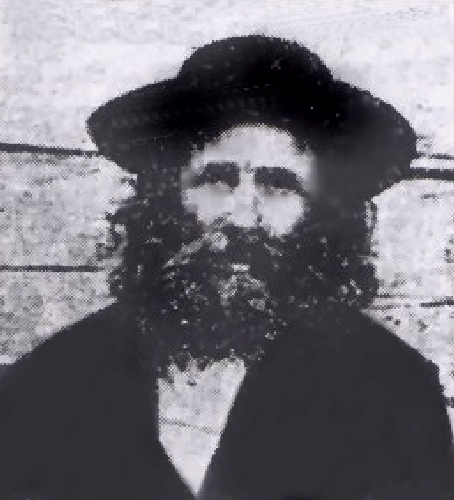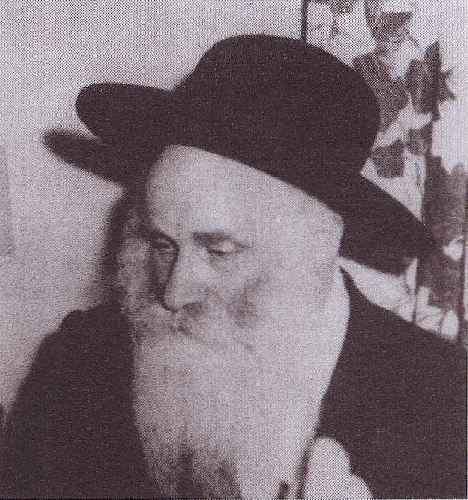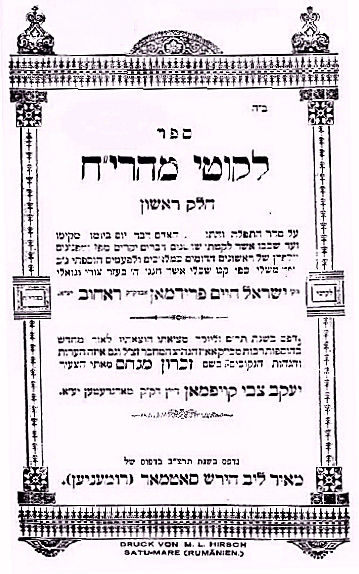| Rakhiv Religious | |
| ~ Religious Life ~ |
|
| There is little doubt that the origin of the Rakhiv Jewish community came much later than those of neighboring communities and was probably first organized in the 1860s, after the gathering of several tens of Galician Jews. Rakhiv was a vibrant village and religion played an important part in the day-to-day lives of Rakhiv's Jews. |
|
The Jews of Rakhiv had two synagogues and three houses of study:
|
|
| The first Rabbi in Rakhiv, Rabbi Yisroel Chaim FRIEDMAN, was elected in approximately 1888. His father was Rabbi Judah FRIEDMAN, "the old Hasid" (from which his son derived the acronym for his book—Likutay Maharyach—[trans. "Ma"—moraynu—our teacher, "har"—ha-rav—the rabbi, "yach"—Judah the hasid or the old hasid - ], who was one of the best students of the author of Yitav Lev and son-in-law of Rabbi Menahem Wolf WEISBERG, head of the rabbinic court in Tarkan in the Zemplin district (who was the son-in-law of Rabbi Jacob Zvi WALDMAN of Bursha). |
|
| The Rabbi of Rakhiv earned his fame in his great composition, the 3 volumes of Likutay Maharyach about the Shulchan Aruch, Orach Chaim, that became a wonderful book among rabbinic works because of its great practicality. The author skillfully wove into the "dry" legal code many unexpected gems of folkways and wisdom, based on very many books, scholars, both ancient and modern, law codes, customs, Kabbala, Hasidism and thus, he strengthened the legal codes and added a pleasing and piquant element appropriate for those used to reading lighter works, but applicable to all. |
|
| As soon as it was published, the book was warmly received and within a short time, it could be found in thousands of homes. It was used by people at all levels, starting with rabbis and learned, sharp-witted scholars to householders troubled with mundane issues of daily life and not able to spend much time attending classes or studying. The book Likutay Maharyach was entirely printed by the author over 11 years. |
|
| The author's grandson (son of his daughter), Rabbi Jacob Zvi KAUFMAN, son-in-law of Rabbi Samuel Zalman WEINBERGER, head of the rabbinic court in Margarten, reprinted the first part of Likutay Maharyach: [bibliographic info in small print] Likutay Maharyach volume 1. Reprinted with many additions [acronym unknown]... the author and some notes ... Zichron Menahem.. Satmar, 5692 (1932). [14], 203, page [1].
|
|
| It appears that Rabbi Jacob Zvi KAUFMAN completed the entire work, but did not publish the other volumes because of a lack of funds. This book, known as Zihkron Menahem, was apparently lost in the Holocaust, as well as its author, the grandson and publiciser of the author of Likutay Maharyach.
|
|
| He is mentioned in a responsum written by the Great Rabbi Eliezer DEUTSCH of Banihad: "We will consult together about the man ... whose wife has been insane this past year and a half" (Responsa Pri HaSadeh, Part 3, Section 186, 1905). |
|
| Rabbi Yisroel Chaim FRIEDMAN died suddenly on 24 Sivan 5682 (18 June 1922) in an accident that occurred while he was on a ritual mission in the Palinina (where the flocks graze) to assure the kashrut (preparation of foods according to Jewish law) of the cheese. He died in a flash flood that struck suddenly, coming after a cloud burst of heavy rain. |
|
| His place was taken by his son, Rabbi Shlomo (Solomon) Zalman FRIEDMAN, a scholar and author of Kedushat Yom Tov and a follower of the rabbi of Sziget. He was also known as a great scholar, a wonderful teacher and a kind person. He was much loved by the Jews of Rakhiv. Between the two world wars, he ran a large Yeshiva (religious school) in Rakhiv, with as many as 150 students. This was, of course, a yeshiva in the Hassidic style, following the tradition of the Sziget Hassidim, but its students included those from other Hassidic groups. Most of the students were from Máramaros, but also from other towns in Carpatho-Rus'. An idea of the diversity of the origins of the student body can be seen in a list of 15 young men who subscribed to the book Responsa Mira (Munkács, 1938), the students came from the following towns: Rakhiv proper (4), Chust (2), Salish, Kiralahana, Trivushan, Bahutz, Novaslitz, Dibova, Nersanitza, Ganitch. This kind of distribution appears to have been representative of all the students. |
|
| Rabbi Shlomo Zalman FRIEDMAN survived the events of the Holocaust. He experienced the horrors of the murderous death camps of Auschwitz and other camps in Germany. After the war he settled in Satmar, where he was head of the rabbinic court and watched over the Jewish life of the survivors that settled in Satmar. He made many efforts, on behalf of agunot and agunim from the Holocaust. (trans. Jews whose spouses were lost needed special procedures to permit them to remarry) In 1947, he escaped from Romania and settled in Logano, Switzerland where he was the head rabbi. He was warmly welcomed by the Jews of the community and in all of Switzerland he was sought out and considered as one of the great halachic decisors. He established certain rules in his community to strengthen religious life. His last years were spent in the home of his son-in-law, Rabbi Menahem Mendel HOROWITZ, in Bnai Brak, Israel. He died at a ripe old age on 4 Sh'vat 5740 (22 January 1980) and he was carried to Jerusalem and interred in the Mount of Olives. |
|
| In 1869, the first shochet (ritual slaughterer) in Rakhiv was Mordecai Dov. After him was Rabbi Yisroel WIRTZBERGER 5639-5640 (1879/80) and after him was Asher ANSHEL. A long standing shochet was Jacob Samson FISHER who died in the 1930s. The last shochetim in Rakhiv were Solomon Leib FALK and Michael SHREIBER, both martyred in the Holocaust. One additional shochet, Zev GREIF, survived the death camps and managed to return to live in Rakhiv. He continued in his holy profession, even under the Communists, until his death on 11 Adar 5734 (5 March 1974). Zev GRIEF was the only mohel (one who performs ritual circumcisions) in the region, and with great dedication, he ensured that Jewish boys entered the covenant of Abraham—our forefather. He persisted, despite official barriers, as well as frequent threats and attempts to frighten him from performing his duties. |
|
| The oldest communal organization was the Chevra Kadisha (burial society), headed by Jacob DORNSTEIN. The organization was managed and supervised by the heads of the community. Among its active members were Zvi Menachem KONITZ, who visited the sick and took care of corpses, all on a volunteer basis. The Shamash (synagogue caretaker) was Yisroel MORDECAI. Surplus funds from the Chevra Kadisha were given to the community to assist the needy, sick or other uses. |
|
| Two communal Torah study organizations existed in Rakhiv. In the study house Hevre Mishnayot, a regular class was taught by Rabbi Zvi SCHEINER, a learned man who was authorized to render Halachic decisor (decisions from interpretation of the Jewish laws). At night, he sat to study and arranged a regular tikkun hatzot (midnight service/study session). When Rabbi SCHEINER went to the synagogue on the eve of the Sabbath, everyone knew that candle lighting time was approaching. In the "old" synagogue, the class was taught by Rabbi Alter SCHIOVICH, who was also a rabbinic dyan (judge) and Halachic decisor and also served as secretary of the community. Many dozens of householders participated in these two classes, many were scholars or least learned men. At each of these synagogues, there were also Hevre Tehillim (Psalms Group) whose members completed the book of Psalms every Sabbath in the afternoon before Mincha (the afternoon service) and the third meal. |
|
| Some charitable and welfare activities were found in Rakhiv, not necessarily well funded, but done with a heartfelt soul. The rabbi of the community managed a charity fund that gave loans to the needy at very reasonable rates (often with no repayment). The rabbi raised the funds from Jews of Rakhiv. The fund brought joy to so many around the town and the rabbi also added to it from his own meager savings. His humble home also served as a lodging for all of the "guests" and fund raisers that found their way to Rakhiv, where they were received cordially. In addition to lodging, they received simple and healthy meals. Mr. Alter FEIG, baal t'shuva (the returner), for many years collected food and supplies for the Sabbath. With a pack on his shoulder, Mr. FEIG wove his way around the town, gathering the supplies into his pack. Each Sabbath eve, there was a long chain of "guests" that accompanied him from house to house, in order to be greeted as a "Sabbath guest" at the home of one of Rakhiv's Jews. |
|
| In 1920, a women's organization called Vered (Rose) was formed. |
|
|
|
| ~ Synagogues ~ |
|
| (Click the image below to view a larger image.) |
|
||||||
| This page is hosted at no cost to the public by JewishGen, Inc., a non-profit
corporation. If you feel there is a benefit to you in accessing this site, your JewishGen-erosity is appreciated. |
| Compiled and created by: Marshall J. KATZ with assistance from: M.Y. EHRENREICH, USA Alik FRIEDMAN, Israel Kehilott Hungary Sefer Mármaros (translated by Eldad M. GANIN, USA) Amos Israel ZEZMER, France and the following: JewishGen members/descendants and contributors of Rakhiv Jewish families: Eldad M. GANIN, USA Chaim MEIERSDORF, Israel Rita (née GREIF) RESNICK, USA |
| Updated: 11 November 2020 |
|---|
| Copyright ©2011 Marshall J. KATZ All rights reserved |
 |
Top of Page |





